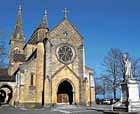Sailing along mountains

It looked vast and remote, stretching for mile after mile reflecting the dusky blue sky. There were not many buildings along its lonely shore, no crowd of swimmers and sunbathers or colourful boats with sails. Yet something about the place drew me irresistibly as we shot past and I decided to return some day and get to know it better.
We made it on a July morning when it was pouring. As we made our way to the hotel, wrapped in raincoats, in what felt like a regular deluge, my only fear was, would the boats ply on the lake in this weather? Luckily a boat trip was scheduled for the evening. That gave us practically the whole day to explore the place. The rain stopped as abruptly as it had started and a listless sun peeped out of the clouds. Neuchatel gets its name from a structure built during the Burgundian rule in 1504 when the place belonged to the French Orleans-Longueville family. Nestled within the steep foothills of the Jura mountains, it has a gorgeous view of the Alps.
Old-world feel
Many of the houses are pale yellow, which had made Alexander Dumas remark that the town was “carved out of a pat of butter”. It stands in the middle of vineyards which stretch all along the lake. Neuchatel is renowned for its red wines and the fruity ‘Œil-de-Perdrix’. People here celebrate the grape harvest with a colourful wine festival. There is a distinct ‘old-world feel’ about Neuchatel which wears a medieval look even today. As we strolled along the cobbled streets we saw time-worn picturesque houses dominated by fountains and towers. Two buildings — a church called La Collegiale Notre Dame and a castle, dominate the scene.
The church is a striking 12th-13th century Roman-Gothic building with multi-coloured glazed tiles. I particularly liked the high, star-covered ceiling and the exquisite stained glass windows. Parts of the original building were destroyed in a big fire in 1450 and were later restored. The Castle, originally the residence of the Neuchatel lords, is now the office of the cantonal government. The buildings, grouped around a large courtyard retain, some of the 12th century features. One of them is the Romanesque Gallery in the southwest wing that has seven blind bays. We were told that the castle had been re-built several times.
Just below the castle stands Hotel du Banneret. Built in 1609, it is a typical Renaissance town house of that time. Another interesting building is the 18th century Hotel Du Peyrou famous for the statue known as The Bather, which stands in a pool of water in the garden. After our jaunt through the old town, we ambled towards the lake, passing by shops with colourful display of chocolates. Neuchatel is famous for its truffle. We stepped into a quaint little shop where the owner told us that the chocolates displayed were not only hand-made but hand-decorated and hand-packaged as well. We ended up buying quite a lot as gifts.
Another sight not to be missed is the Neuchatel Natural History Museum. This entire area used to be the heart of Iron Age culture known as La Tene (500 BC-0 BC). In the 1870s, the eastern end of the lake dried out and many objects belonging to the period were discovered. They have a special character of their own and are known as La Tene art. Among these finds are the remains of a yoke, which dates back to 200 BC.
Finally, we were at the lake for the boat ride I’d been eagerly waiting for. The jetty was totally deserted. There was not a single soul around. Nothing but ducks, swans and seagulls floating gracefully along the fringe of the lake. We were the only two passengers aboard, though another family joined us later. I was disappointed that I could not see the Mont Blanc and the Bernese Oberland Ranges because of the low clouds. Normally one can see both the ranges from the lake.
Nevertheless, the cruise was exciting enough as we cut across the dark waters with a strong wind blowing. We learned from the big map on the boat that the first steamer in Switzerland had plied on this very lake in 1827. The largest lake in Switzerland, Neuchatel is not shared by neighbouring countries. Being 38.3 km long, 8.2 km wide with a maximum depth of 152 m, the lake owes its origin to a former glacial lake at the base of the Jura mountains.
We enjoyed a meal of fresh fried fish and chips, washed down with huge glasses of iced tea on board. Our boat touched various ports — Grandson, Saint-Aubin-Sauges, Cortaillod, Colombier and St Blaise. Suddenly the clouds lifted for a moment and we held our breath as we caught a fleeting glimpse of the majestic Mont Blanc. Then, it was dark once again and it started raining. As we trudged back to our hotel in the rain, I thought of the glorious sight which would remain in my heart forever.
Deccan Herald is on WhatsApp Channels| Join now for Breaking News & Editor's Picks